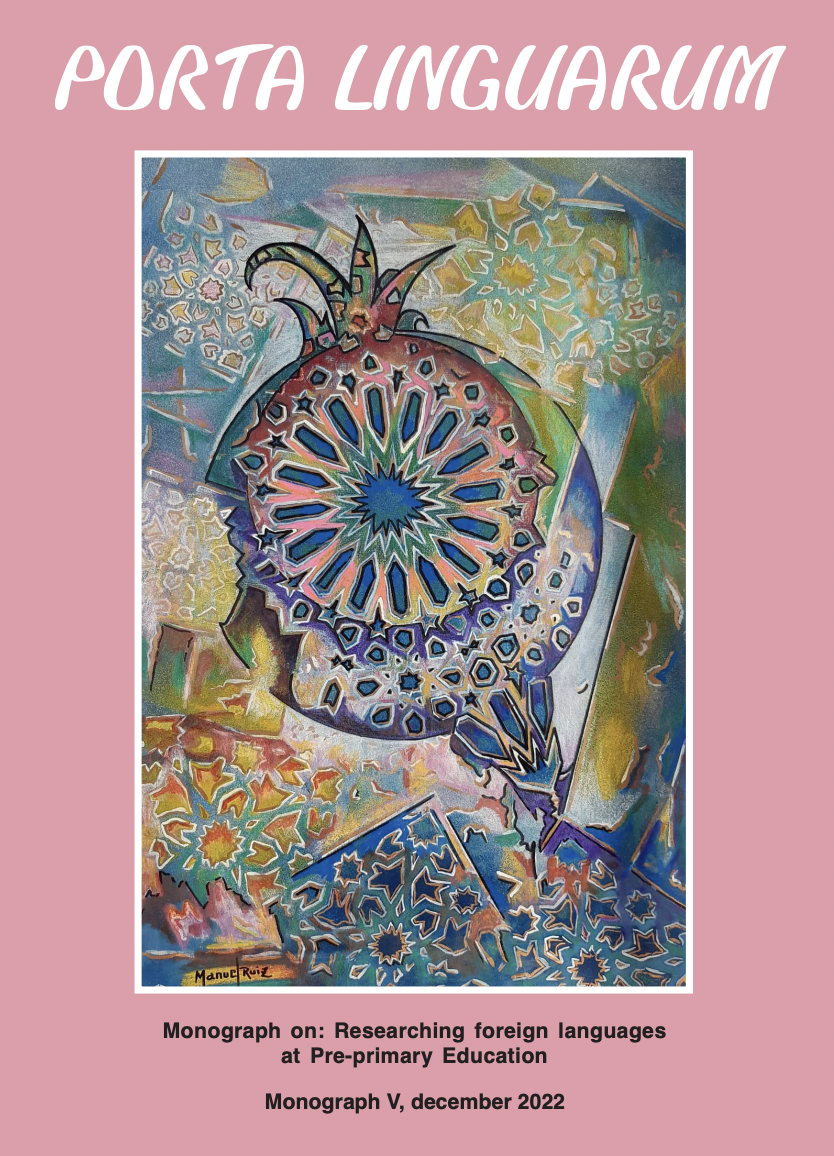DivCon: un modelo para desarrollar la conciencia de la diversidad lingüística y cultural a temprana edad
DOI:
https://doi.org/10.30827/portalin.vi.26211Palabras clave:
linguistic diversity, cultural diversity, language awareness, young language learners, language awakeningResumen
El artículo se centra en el desarrollo de la conciencia de la diversidad lingüística y cultural en preescolar. En primer lugar, presentamos el modelo DivCon (Diversidad en Contexto), que propicia la exposición sistemática a la diversidad lingüística y cultural y se basa en un marco integrador de seis aspectos: la metáfora del viaje, la exposición a la diversidad lingüística, la exposición a la diversidad cultural, la progresión de lo concreto a lo simbólico, los enfoques eficaces para la enseñanza de segundas lenguas y la participación de los niños . En la segunda parte presentamos los resultados de un estudio cualitativo llevado a cabo con tres grupos preescolar (n=40) para evaluar el modelo en el contexto esloveno. Dicho estudio tenía como finalidad analizar las respuestas de los niños a las diferentes dimensiones del modelo y la manera en que ellos perciben las diferentes lenguas y culturas. Los resultados indican que los participantes tuvieron una respuesta positiva a las actividades realizadas para evaluar el modelo propuesto y mostraron que son conscientes en varios modos de la diversidad lingüística y cultural. Consideramos que el modelo ofrece estrategias eficaces para desarrollar la conciencia lingüística y actitudes positivas hacia la diversidad lingüística y cultural.
Descargas
Citas
2. Asher, J. & Silvers, S. M. (2003). How to TPR abstractions: the critical role of imagination. The Journal of the Imagination in Language Learning and Teaching. New Jersey City University, ERIC, 56-61.
3. Bratož, S. & Sila, A. (2021). Developing plurilingual competence at an early age. In: C. J. MCDermott & A. Kožuh (Eds.) Educational challenges (pp.101-119). Los Angeles: Department of Education, Antioch University, 101-119.
4. Candelier, M., Camilleri, A., Castellotti, V., De Pietro, J. F., Lőrincz, I., Meißner, F.-J., Noguerol, A., & Schröder-Sura, A. (2010). A framework of reference for pluralistic approaches to languages and cultures. Competences and resources. Austria: Council of Europe.
5. Coelho, D., Andrade, A. I., & Portugal, G. (2018). The ‘Awakening to Languages’ approach at preschool: developing children’s communicative competence. Language awareness, 27(3), 197-221.
6. Cots, J. M. (2008). Knowledge about language in the mother tongue and foreign language curricula, Encyclopedia of language and education, 6, 15-30.
7. Coyle, D., P. Hood, & D. Marsh. (2010). Content and Language Integrated Learning. Cambridge University Press.
8. Čotar Konrad, S. The role of preschool teacher in empowering functionality of family of preschool child. Didactictica Slovenica, 33(1), 70–81 (2018).
9. Darquennes, J. (2017). Language Awareness and Minority Languages. In J. Cenoz, D. Gorter & S. May (Eds.), Language Awareness and Multilingualism, Encyclopaedia of Language and Education, 297-308.
10. Finkbeiner, C. & White, J. (2017) Language awareness and multilingualism: A historical overview. In J. Cenoz, D. Gorter & S. May (Eds.), Language awareness and multilingualism, encyclopedia of language and education. New York, NY: Springer International Publishing AG.
11. García, O. & Wei, L. (2014). Language, bilingualism and education. In Translanguaging: Language, bilingualism and education, 46-62. Palgrave Pivot, London.
12. Hoff, E. & Naigles, L. (2002) How children use input to acquire a lexicon. Child Development, 73(2), 418–433.
13. Laevers, F. (2005). Well-being and involvement in care settings. A process-oriented self-evaluation instrument. https://www.kindengezin.be/img/sics-ziko-manual.pdf
14. Lakoff, G. (1993). The contemporary theory of metaphor. In A. Ortony (ed.), Metaphor and thought, 202–251.
15. Lakoff, G. & Johnson, M. (1980). Metaphors we live by. Chicago: University of Chicago Press.
16. Lesar, I., Majcen, I., & Podlesek, A. (2020). Stališča (bodočih) pedagoških delavcev kot temelj kakovostnega vključevanja otrok priseljencev. Dve domovini, (52).
17. Little, D., Leung, C., & Van Avermaet, P. (Eds.). (2013). Managing diversity in education: Languages, policies, pedagogies, Multilingual matters (33).
18. Marsh, D. (2012). Content and language integrated learning (CLIL): A development trajectory. Córdoba, Spain: University of Córdoba.
19. Pirih, A. (2019). Extensive reading and changes to reading motivation in EFL among Slovene primary school pupils. Journal of Elementary Education, 12(4), 291-314.
20. Rutar, S. (2014). Multilingual learning and teaching as a principle of inclusive practice. Journal of Contemporary Educational Studies/Sodobna Pedagogika, 65(1).
21. Sayers, D. & Láncos, P. L. (2017). (Re) defining linguistic diversity: What is being protected in European language policy? SKY Journal of Linguistics, 30, 35-73.
22. de Sousa, E. B. C. (2019). Five Tips for Engaging Multilingual Children in Conversation. YC Young Children, 74(2), 24-31.
23. de Sousa, E. B. C. (2017). Promoting the contributions of multilingual preschoolers. Linguistics and Education, 39, 1-13.
24. Svalberg, A. Language Awareness research: where we are now. Language Awareness, 25(1), 1-13 (2015).
25. Štemberger, T. (2019). Raziskovanje o otrocih/z otroki: vprašanje participativnega raziskovanja z otroki. Pedagoška obzorja: časopis za didaktiko in metodiko, 34 (1), 3-18.
26. Wei, L. (2018). Translanguaging as a practical theory of language. Applied linguistics, 39(1), 9-30.



















